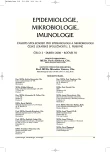Long-term Experience with Testing Family and Sexual Contacts of HBsAg Positive Persons
Authors:
P. Pazdiora; Z. Böhmová; A. Kubátová; I. Menclová; I. Morávková; J. Průchová; M. Přechová; M. Spáčilová
Authors‘ workplace:
Krajská hygienická stanice Plzeňského kraje
Published in:
Epidemiol. Mikrobiol. Imunol. 55, 2006, č. 2, s. 53-58
Overview
The study objectives were to identify HBsAg positive persons and to offer free vaccination against the infection to their family and sexual contacts found negative in screening for viral hepatitis B (VHB) postinfection markers.
Material and Methods:
Any person testing HBsAg positive in the Plzeň region was registered in cooperation with laboratories. The collected data included reason for testing, clinical diagnosis and ethnicity. Contacts were screened for postinfection markers and vaccinated.
Results:
Between 1997 and 2004, 939 HBsAg positive persons were registered by laboratories in the Plzeň region. Their mean age was 42.2 (0–90) years. As many as 63.4 % of the infected persons appeared to be „healthy“ carriers. Nevertheless, a significant upward trend in HBsAg positivity was recorded among immigrants (mainly those from Vietnam). Altogether 18.2 % of 829 family and sexual contacts tested positive for VHB postinfection markers (HBsAg, anti-HBc). The highest percentages of infected contacts were detected among siblings and parents of HBsAg positive persons (36.5 % and 27.3 %, respectively). Free vaccination has been requested by 82.2 % of susceptible contacts.
Conclusion:
Systematic vaccination of family and sexual contacts of HBsAg positive persons can contribute to more rapid VHB elimination in the Czech Republic. Currently, special attention in detecting infected persons is to be paid to immigrants from Asia.
Key words:
viral hepatitis B – intrafamily transmission – vaccination.
Labels
Hygiene and epidemiology Medical virology Clinical microbiologyArticle was published in
Epidemiology, Microbiology, Immunology

2006 Issue 2
Most read in this issue
- West Nile Virus
- Medium with Amikacin for Laboratory Diagnosis of Beta-haemolytic Streptococci
- Outbreak of Marburg Hemorrhagic Fever in Angola
- Epidemiological Characteristics of Diabetes Mellitus in Slovakia, 1992–2002
